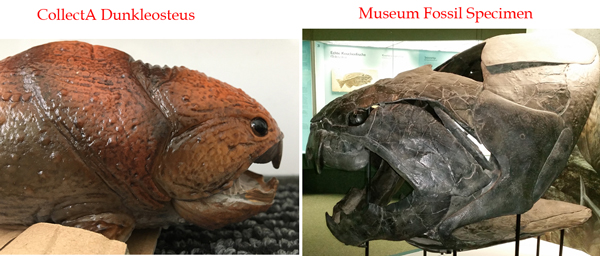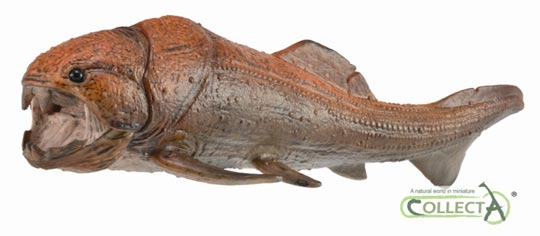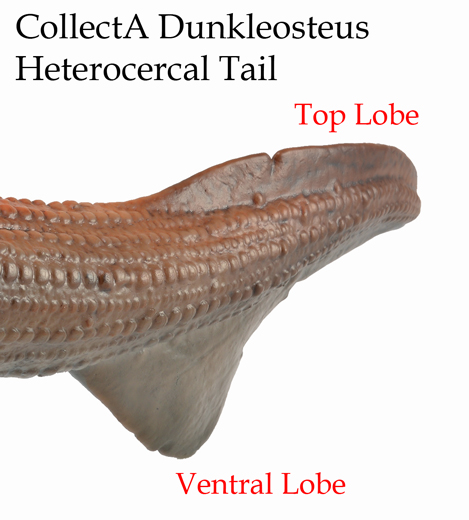Praising the CollectA Deluxe 1:20 Scale Dunkleosteus Model
CollectA have stated that they intend to introduce more figures and replicas that represent animals from the Palaeozoic into their model range. True to their word, 2018 has seen the introduction of a Dimetrodon along with an Estemmenosuchus, models of animals that lived during the Permian. In addition, CollectA have added a 1:20 scale Dunkleosteus to their Deluxe range.
The Dunkleosteus figure has attracted a lot of praise from model collectors and from curators of vertebrate fossil collections around the world.
The CollectA Dunkleosteus Model Compared to a Museum Specimen

Picture credit: Everything Dinosaur
The picture (above), shows a close-up view of the anterior portion of the new for 2018 CollectA Dunkleosteus model (left). The use of gloss on the figure gives this model an attractive wet-look, very appropriate for a Late Devonian marine predator. To the right, is a photograph of a Dunkleosteus exhibit on display at the Senckenberg Naturmuseum Frankfurt in Germany. The production team at CollectA have taken great care to depict the famous jaws and the bony head shield of this prehistoric fish accurately.
Dunkleosteus is a member of the Placodermi (plated skins), a Class of armoured fish, that was extremely varied, geographically widespread and specious.
Dunkleosteus – Huge Skull Plates and Shears for Jaws
Although Dunkleosteus (D. terrelli), is regarded as an iconic animal in the fossil record, it is only known from its massive skull plates and shear-like jaws, although recently, some details were published on the discovery of a fragmentary piece of fossilised cartilage associated with supporting the tail (ceratotrichia). The rest of the animal, its backbone, soft tissues, the shape of its fins and tail are not known. In order to produce a 1:20 scale model, the designer at CollectA has had to make an educated guess about the body plan of Dunkleosteus.
Designer Anthony Beeson got inspiration from other Devonian placoderms as well as using living fish when it came to devising the shape of the CollectA model.
The CollectA Deluxe Dunkleosteus Figure
Picture credit: Everything Dinosaur
The bony plates and jaws that have been preserved give scientists an impression of what the front of this fish looked like, but the remainder, more than two thirds of the entire animal is simply not known to science. The CollectA model has been given a short, but broad dorsal fin. Other better known and much smaller placoderms had similarly shaped dorsal fins. These fishes also possessed paired pelvic and pectoral fins, so the CollectA model has been provided with these as well.
A Heterocercal Tail
The CollectA figure has been given a heterocercal tail. Heterocercal tails are not symmetrical. The vertebrae extend into the top lobe of the tail and this makes it longer than the lower or ventral lobe. Heterocercal tails are known in members of the Placodermi and these types of tails are also found in many species of shark. The CollectA Dunkleosteus tail has some nicks in both the top and ventral lobe, typical wear and tear as expected in the fins of an apex predator and from a fish that may have been subject to attack from members of its own species (intraspecific combat).
A View of the Heterocercal Tail of the CollectA Dunkleosteus Model
Picture credit: Everything Dinosaur
Visit the Everything Dinosaur website: Everything Dinosaur.
Head Shield Covered in Skin
The huge bony plates that covered the anterior portion, of what many scientists have described as the world’s first vertebrate super-predator, are frequently described as armour. The head was actually covered by a tough skin, as much as eight centimetres thick in some areas. The headshield very probably did provide protection, but they also served as anchor points for the huge muscles needed to power the jaws of this prehistoric fish.
Recent research undertaken by the Cleveland Museum of Natural History (Ohio), that houses an extensive collection of placoderm fossils, indicates that Dunkleosteus had a very powerful bite, at least as powerful as that of top aquatic predators today such as alligators and sharks.
Commenting on the CollectA Dunkleosteus Figure
Commenting on the shape of the figure, including the raised area immediately behind the jaws, designer Anthony Beeson stated:
“The hump (which isn’t supposed to be anything of the sort), is simply the result of having the bony skull embedded in the body of the Dunkleosteus, rather than to just have it resting on the surface of the fish like a suit of armour as other firms have done. If there is a resulting hump that is purely my take on how it may have appeared. As the skull is the only thing preserved in the fossil record the rest of the animal is pure speculation as any artist or modeller has to do. No one for instance is certain on how the tail may have looked. One has to look at contemporary and modern species and also think what will make the model attractive both visually and touch-wise. The skin ornamentations are not scutes, but I based them on the skin of the Devonian fossil fish Gemuendina and other skin decoration on those of large modern fishes such as the Wolf Fish.”
To view the CollectA Dunkleosteus and the other figures in the CollectA Deluxe model range: CollectA Deluxe Prehistoric Life Models.








Leave A Comment